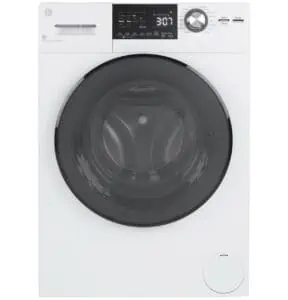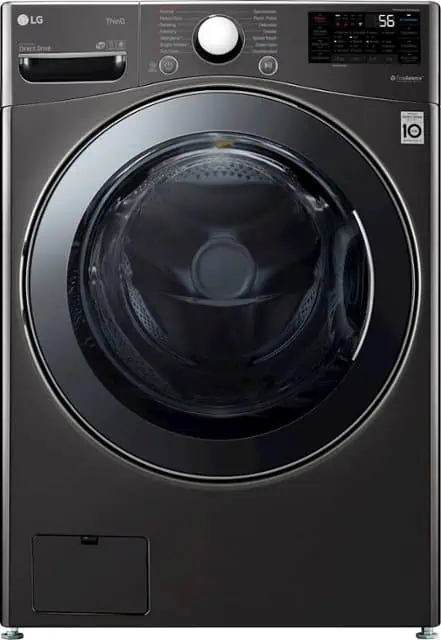Washer dryer combos might seem like the perfect space-saving solution, but they often come with a host of problems. From wrinkled clothes to long drying times and limited capacity, they can be quite disappointing.
Speaking from personal experience, I remember living in a tiny studio apartment after college. Having an integrated washer and dryer was an absolute lifesaver. But, as I’m sure many of you can relate, they can be pretty loud – especially when they’re basically in your bedroom!
While they may seem like a convenient option, you’ll likely be disappointed by even the best washer dryer combos. In the end, it’s worth considering separate, dedicated washer and dryer units to save yourself from the laundry headaches combo units may cause.
For those who are space-limited and still want a combo washer and dryer, I’ve done the research and review to find the top quiet options available.
Our Top 4 Picks
1. Top Pick: GE Compact Washer and Dryer (GFQ14ESSNWW)
- Noise level: Not specified
- Capacity: 2.4 cu. Ft.
- Drying type: Ventless
- Energy Efficiency: 108 kWh/yr
- Max spin speed: 1450 RPM
- Vibration control feature: Yes
- Heat settings: 5
- Hot water cycle: Yes
- Load sensing for water filling: Yes
- Scheduled start: Yes
- Dimensions: 33.25″ x 23.44″ x 25.63″
This GE washer and dryer has quite a small capacity, but this makes it ideal for apartments, dorms, or other small spaces. Provided you don’t need loads of functionality, it might be the best washer dryer combo for your needs.
Build Quality
The build quality is pretty standard for a washer dryer combo. It’s made of steel with a white coating. As such, it’s not the most interesting quiet washing machine, but not many people buy a washing machine for its appearance!
It’s an integrated washer dryer combo, meaning the dryer is built into the same appliance. As I explain below, this isn’t the best option, but it certainly helps save space in your home.
Capacity
Its capacity is 2.4 cu. ft., which classifies this as a compact model. While this isn’t loads, it should be fine for a single person or for a couple who don’t mind doing a lot of laundry!
Noise Level
Unfortunately, there isn’t a noise level listed for this model. It includes vibration reduction technology, which means vibration control when spinning unbalanced loads. In layman’s terms, it means it adjusts the rotation speed to reduce the centrifugal force of the unbalance, thus reducing vibrations.
Various reviewers say the model is quiet, although its draining noise can be loud in the middle of the night. However, this shouldn’t come as a massive surprise.
Functions
It’s a ventless washer dryer combo, meaning it includes a condenser, so you don’t need an exhaust pipe. It has 14 wash and rinse cycles and 16 drying cycles, giving you plenty of options. This includes a steam cycle, which can help lift stains like grass as an eco-friendly alternative to using bleach.
This appliance has optional WiFi connectivity. However, you need to install the GE Connect Plus, which is sold separately.
Energy Efficiency
This GE is Energy Star certified, which is helpful considering dryers can be very energy intensive. According to its energy label, it uses 108kWh of energy a year, which equates to around $13. This is pretty good considering it includes a tumble dryer.
Downsides
One issue reviewers note is that it doesn’t drain amazingly if there’s a buildup of lint and hair. The solution is to run an empty cleaning cycle, although this obviously uses more energy. Other than this, another problem is that clothes don’t dry completely, but this is often the case with integrated washer dryers.
- Compact model – ideal for apartments.
- Energy Star certified.
- Loads of settings.
- Drainage isn’t great.
2. Top Premium Pick: LG High-Efficiency Front Load Washer and Dryer
- Noise level: Not specified
- Capacity: 4.5 cu.ft
- Drying type: Ventless
- Energy Efficiency: 105 kWh/yr
- Max spin speed: 1300 RPM
- Vibration control feature: Yes
- Heat settings: 3
- Hot water cycle: Yes
- Load sensing for water filling: Yes
- Scheduled start: Yes
- Dimensions: 39″ x 27″ x 30.25″
This LG washer dryer is another integrated model. It missed out on the top spot on this list because of its price, but its functionality and capacity are both pretty good.
Build Quality
The washer dryer combo is well built – as you should expect from a company like LG. It’s a ventless dryer, meaning it has a condenser. This makes placement more flexible and means it should be suitable for anywhere in the home that has a water inlet.
Capacity
Its capacity is 4.5 cu. ft., which puts it on the lower end of a large washer, although it’s arguably more of a standard-sized washer. Its size should be enough for a couple or small family laundry loads. The drying cycle can handle a full load of washing too.
Noise Level
There isn’t any mention of a specific decibel rating for this washer dryer combo. However, reviewers state that it’s pretty quiet – it features vibration reduction technology to help keep the noise level down.
We can look elsewhere in the LG range for a comparable model. The company has a quiet washing machine that operates at 55dB when washing and 75dB during its spin cycle. Its dimensions, capacity and build are similar, so we can assume they operate at similar range of noise levels.
Functions
The washer has 14 settings that you control via a dial and touchscreen. The dryer has 12 cycles, so you’re covered from both angles for all the kinds of laundry you might need to do.
You can control both via WiFi and voice assistant – it’s compatible with Alexa and Google Assistant.
Energy Efficiency
This washing machine has a very good energy efficiency rating of 105 kWh/yr, even though it’s not Energy Star certified. This rating includes the heater function, and paradoxically to its lack of Energy Star certification, the LG is the most efficient in our list of products reviewed.
Downsides
Users state the dryer isn’t amazing. But as mentioned above, this is a common problem with an integrated washer dryer combo. Provided you can give the clothes an air after drying, it shouldn’t be a problem.
- Fairly compact model with decent capacity.
- Plenty of washing and drying functions.
- Ventless dryer makes placement flexible.
- Dryer doesn’t do an amazing job.
3. Top Budget Pick: Comfee Washer Dryer Combo
- Noise level: 63 dB
- Capacity: 2.7 cu.ft
- Drying type: Ventless
- Energy Efficiency: 90 kWh/yr
- Max spin speed: 1400 RPM
- Vibration control feature: Yes
- Heat settings: Not specified
- Hot water cycle: Yes
- Load sensing for water filling: Not specified
- Scheduled start: Yes
- Dimensions: 33.5” x 25.2” x 23.4”
The Comfee Washer and Dryer Combo is a compact all-in-one washer dryer combo that’s suitable for apartments or other places where space is at a premium. You can see it as a budget model and a more compact model than the LG above.
It’s worth noting that it suffers from the same downsides as other all-in-one washer dryers, while doing the job decently for its price.
Build Quality
At 23.5” wide, this is a pretty compact washer dryer. As with other models, it’s made from steel and plastic and has a stainless steel drum. Its budget-friendly price point isn’t particularly obvious in its build quality, which is a good sign.
Capacity
The drum is 2.7 cu. ft. and can hold around 26 lbs. of washing. However, its dryer capacity is 13 lbs., implying you’ll need to split your laundry load in half to dry it. This isn’t the biggest issue in the world, but it does objectively mean it’ll take twice as long to dry your laundry, and that you can’t simply set it and go.
On the other hand, the spin speed is at the top end of the scale, sitting at 1400 RPM. Take the example of the LG above, which at 1300 RPM, spins around 7% slower.
Noise Level
This washer dryer operates at a noise level of 63dB, which is within the acceptable range for most users. According to our data analysis, this noise rating is likely to correspond to the wash cycles.
If you want a really quiet washer, you might want to look for something in the 50-55dB range. But those models are usually more expensive. This washer dryer offers a good balance of price and performance that should be fine for most buyers.
Functions
The Comfee has all the settings you expect from a washer dryer. It puts emphasis on its Overnight Laundry setting, which is self-explanatory. You put laundry in overnight and it’s clean and dry by the morning. But, as I’ve mentioned, its dryer capacity is half of its washing capacity. As such, it’s only suitable for small loads.
Energy Efficiency
According to the Energy Guide label, this washer dryer uses 90kWh of energy a year. This works out at about $11 a year, which is perfectly acceptable for running an appliance like this.
If you’ve read this far, you might wonder why I don’t mention it being the most efficient on this list. After all, it’s superior to the 105 kWh/yr displayed by the LG.
The Comfee has a capacity 2 times smaller than that of the LG. It means for roughly 100 kWh/yr, the LG can clean twice more clothes than the Comfee.
Downsides
Various users state the Comfee takes ages to run a cycle and doesn’t do a great job of drying. However, based on my experience, neither of these is unique to the Comfee but are rather issues with all combo washer dryers. It apparently takes 6 hours to complete a cycle, so bear that in mind if you’re in a rush!
- Great features for the price point.
- Compact design makes it suitable for apartments.
- Energy efficient.
- Takes ages to complete a cycle.
- Drying capacity is smaller than washing capacity.
4. Best Vented Combo Washer and Dryer: Equator Pro Washer and Dryer Set
- Noise level: Not specified
- Capacity:
- Washer 1.6 cu.ft
- Dryer 3.5 cu.ft
- Drying type: Vented
- Energy Efficiency: 96 kWh/yr
- Max spin speed: 1200 RPM
- Vibration control feature: Not specified
- Heat settings: Not specified
- Hot water cycle: Yes
- Load sensing for water filling: Yes
- Scheduled start: Yes
- Dimensions: 59” x 23.5” x 22”
Vented dryers can be a more cost-efficient solution, as they don’t use as much energy and are generally cheaper in the first place. Plus, since all-in-one washer dryers aren’t vented, you’ll sidestep their common pitfalls by choosing separate units.
This combo set from Equator is a good option if you need a separate washer and dryer with decent functionality and few extra frills.
Build Quality
Both the washer and dryer are sturdy and compact, making them suitable for everything from small homes to RVs. They’re stackable, although you could obviously position them side-by-side too.
Capacity
The washer has a capacity of 13 lbs., which is a decent-sized load of laundry. There’s no mention of the dryer’s capacity, but based on the size, it’s fair to assume it can handle a whole load of laundry from the washer.
Noise Level
While there’s no listing for the general noise output of these models, the washing machine has a quiet mode. This runs at less than 60dB, which is pretty quiet. However, it does bottleneck the spin speed, meaning your laundry will come out damper than you might want.
Functions
The washer has 12 programs for different kinds of laundry, and the dryer has a dial for choosing the temperature and drying time. Both come with a winterize function, making them suitable for storing in an RV or using in an outbuilding/garage.
Energy Efficiency
These appliances are Energy Star rated and consume 96 kWh/yr on average. As a consumer, just knowing they’re Energy Star rated is enough to not be concerned about your electricity bill.
Downsides
Some users state that the washer takes a while to complete a load of laundry, but this is partly because of its size and lower spin speed (1200 RPM). Many users state it’s ideal for an RV, though, due to its compact size.
- Ideal for compact spaces.
- Has a quiet mode – less than 60dB.
- Decent capacity for its size.
- Washer takes a while to complete a load of laundry.
Noise Level of Washer & Dryers
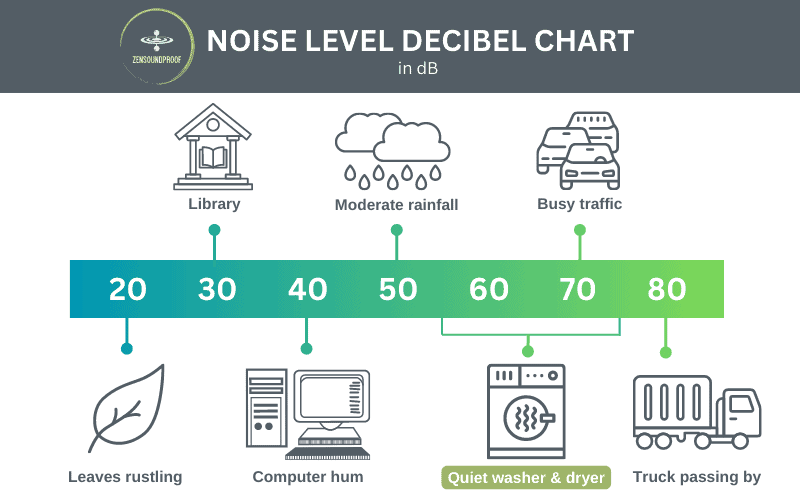
Generally, a washing machine will be louder than a tumble dryer. You can expect a washer to be 75dB or more in its spin cycle, and around 55-60dB in its wash cycles. A dryer will typically be around 70dB. For a quiet washer and dryer, look for a model that’s below 75dB. Of course, the quieter you can get, the better, particularly if it’s installed in your kitchen.
| Noise Level Comparison | Description | Decibel (dB) |
|---|---|---|
| Washing Machine (spin) | Louder than tumble dryer, similar to a vacuum cleaner | 75 or more |
| Washing Machine (wash) | Comparable to normal conversation | 55-60 |
| Tumble Dryer | Comparable to a busy street | 70 |
| Quiet Washer & Dryer | Quieter than average | Below 75 |
| Busy Street | Moderate noise level | 70 |
| Truck Passing | Loud noise level | 80 |
| Normal Conversation | Quiet noise level | 60 |
For some real-world comparisons, 70dB is around the level of a busy street, and 80dB is about the volume of a truck passing you. To provide a bit more context, 60dB is roughly the level of normal conversation.
Noise Sources
To help you pick out the quietest washing machine you can find, it’s worth understanding where noise actually comes from in this appliance. Generally, the washing machine is going to be the louder part, as a tumble dryer is a comparatively simpler machine.
Here are the main sources of noise in a washer and dryer:
Water Filling and Draining
The washing machine filling with water can make a reasonable amount of noise because it’s powered by a pump. It won’t be the loudest or most unpleasant noise, but there can be banging and thumping as the pump turns on and off and water is drawn through the detergent and fabric softener drawers.
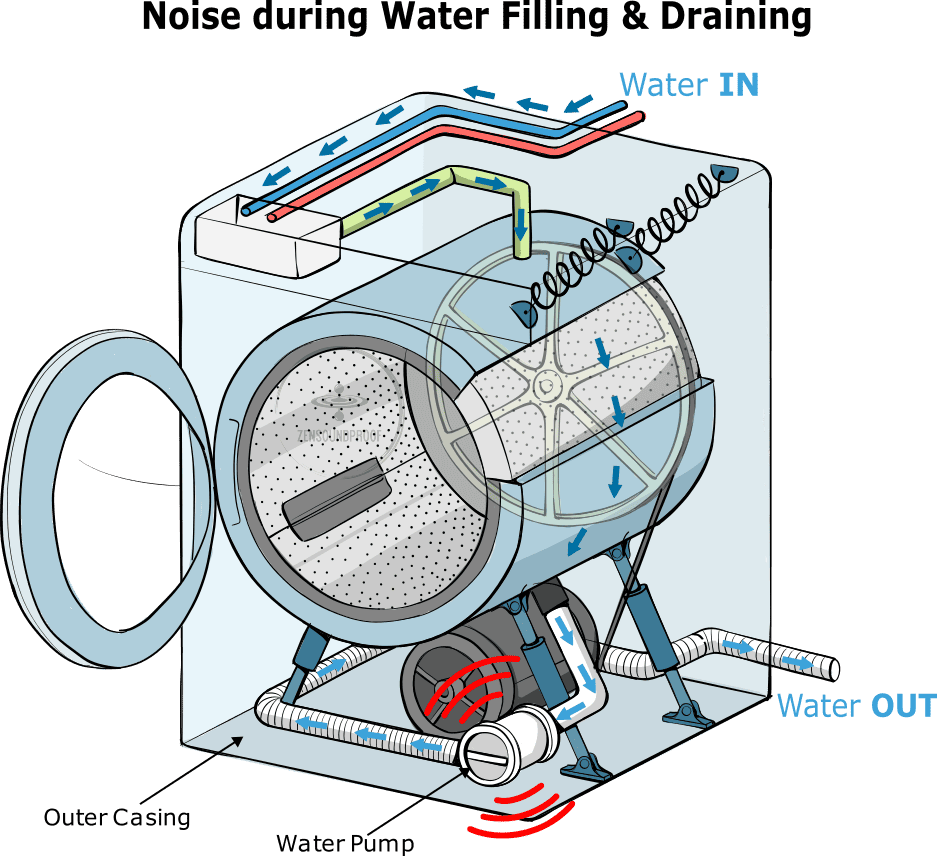
Similarly, water draining out of the washing machine will cause a pumping noise. It’ll be on par with the water filling noises because it’s the same process, just in reverse.
Vibration Transmission
Washing machines create quite a lot of vibrations as the drum turns during the wash cycle. These vibrations transmit from the drum and motor into the casing and, usually, into the floor or surrounding housing.
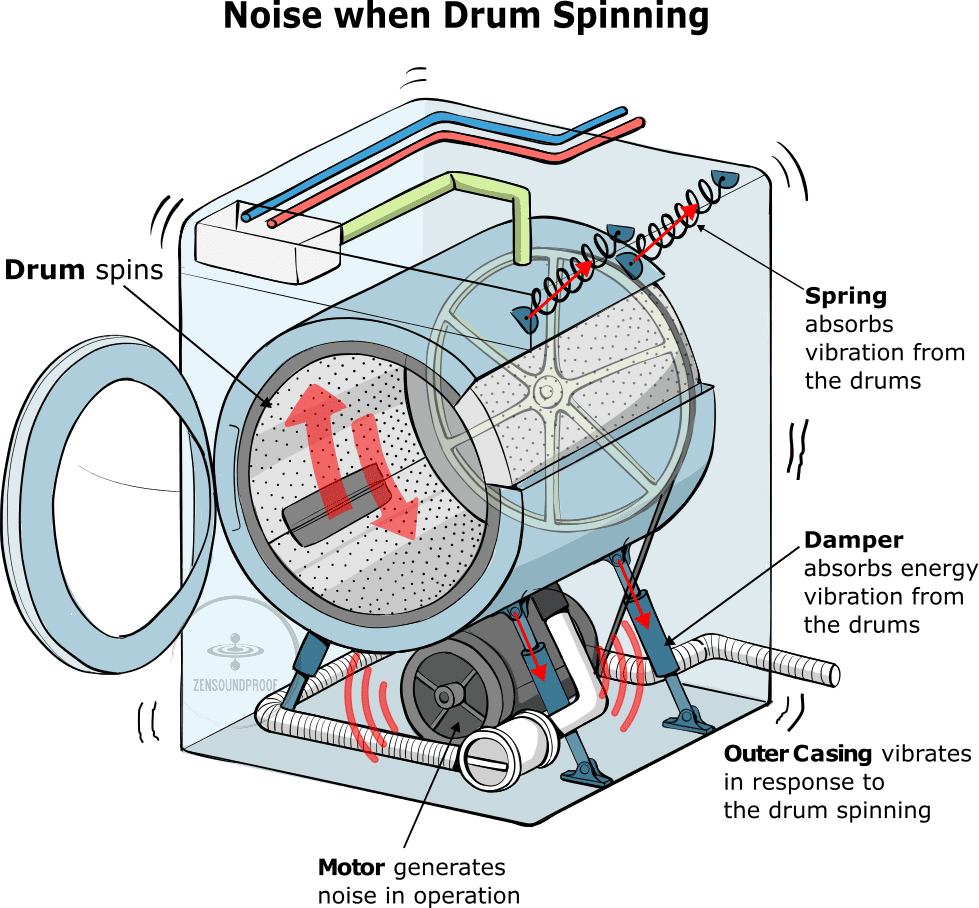
A major factor in noise levels here is whether the machine’s feet are level. If not, the vibrations will seem amplified by the machine wobbling as the drum spins.
Motor and Tumbler Noise
Arguably the loudest part of the washing and drying process is the drum spinning. A washer’s spin cycle can be 1200 RPM or more, which creates a lot of noise. Along with the actual spinning noise, the cycle can create a lot of vibrations, particularly if the washer isn’t properly balanced.
Hot Air Blowing
Tumble dryers are generally much quieter than washers, but their main source of noise (other than the clothes tumbling) is hot air blowing in the tumble. However, this isn’t usually a particularly distracting noise, but it’s worth mentioning anyway.
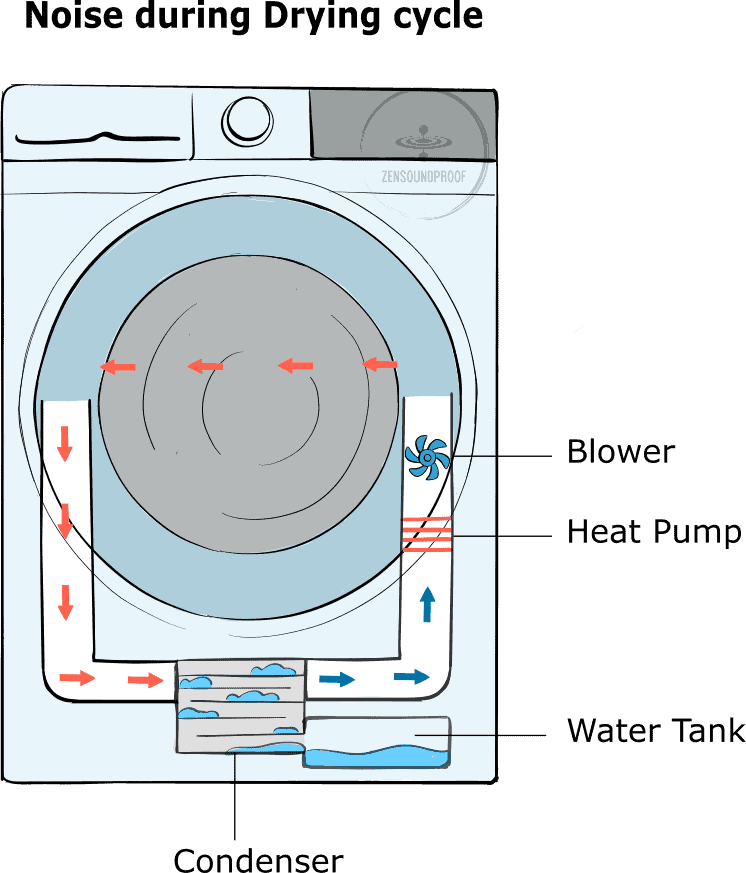
Washer dryer combos are ventless, meaning the air is not blown outside but recirculated within the unit.
Vented models tend to be noisier because of the pressure released to the outside, via the vent hole. This can vary depending on the geometry and placement of the vent.
Buying Guide
Picking a washer dryer set can be a bit more complex than with other household appliances. That said, if you read through the criteria below, you should be able to narrow down your choices.
Noise Level
There’s not much else to say about noise level. As you can see, it’s not that common for washer dryers to include a noise level in their specs. However, if you can find one, this should be your starting point for narrowing down your options.
Capacity
Generally, we’ll work on the washing machine’s capacity rather than the dryer’s – at least for integrated machines. Here’s a handy chart to help you understand capacities in terms of machine size and dirty laundry weight:
| Machine Size | Cubic Feet | Pounds of Laundry |
|---|---|---|
| Compact | 1.5-3.4 | 4-8 |
| Standard | 3.5-4.4 | 12-16 |
| Large | 4.5-5 | 16-20 |
| Extra Large | 5.1-6.2 | 20-25 |
For reference, a normal t-shirt weighs about half a pound and jeans weigh around 1.6 lbs. Using this information, you should be able to work out the most suitable capacity for your new washing machine.
The only other thing to bear in mind is that dryers have a larger capacity to compensate for the extra water weight. It’s standard for the dryer in a combo set to be able to handle a standard load from the washer.
Motor Type: Direct Drive vs. Belt
Washing machines use either direct drive or belt drive motors.
Direct Drive
Unsurprisingly, direct drive motors have the washing drum connected to the motor shaft. Some benefits include:
- They’re quieter because there’s no friction between the motor and belt.
- They also last longer as a result
- Generally, they include extra vibration control
However, as a result, direct drive washers are often more expensive.
Belt Drive
As the name suggests, these washers use a drive belt to spin the drum. While they’re louder as a result, some benefits include:
- Belt drives are cheaper to repair because you don’t need to replace the entire motor.
- They’re a much cheaper technology.
- They have a power transmission efficiency that’s similar to a direct drive transmission (around 95-98%)
Based on my experience, I’d recommend opting for direct drive where possible if quietness and speed are your main priorities. However, belt drive will be fine if you’re looking to save money, as the difference in noise level isn’t considerable.
Wash Programs
Unless it’s your first time buying a washing machine, there isn’t much need to cover wash programs in detail. At the very least, you’ll want hot, warm and cold temperature settings and variable spin speeds.
Specific functions for delicates and wool can be helpful, but it’s usually better to handwash these items anyway.
As for dryer programs, you’ll want hot, cold, and timed. Air dry settings are helpful, but the things that can only be air dried are better to actually be air dried if possible.
Some higher-end models have loads of extra programs and even things like WiFi compatibility. Whether these functions are necessary is debatable, as I’ve gotten along fine in my life only using about 3 settings on my washing machine!
Spin Speed
A washer’s spin speed can have a big impact on its noise output. However, it’s (unsurprisingly) also related to how dry the clothes are when the cycle finishes.
Most standard washing machines operate between 1200 and 1400 RPM. Ideally, you’ll want a machine with adjustable speeds, so you can wash wools and delicates properly (around 600-800 RPM).
Integrated Vs. Separate Dryer
If possible, opt for a separate dryer rather than an integrated one. They dry clothes far more efficiently and generally have a larger capacity. Integrated dryers have to contend with the extra moisture left over from the wash cycle, meaning they can take much longer.
Where space is a priority, consider looking for stackable washer dryer combo units. They make use of vertical space, allowing you to have separate washer dryers without taking up more floor room.
A combo washer dryer might save space in your laundry room, but they’re not the most efficient options. I always found mine would take ages to dry my clothes, and they’d also come out creased.
Where possible, I’d always recommend buying separate appliances, which I cover in their own dedicated articles.
Ventless Vs. Vented
For separate dryers, another consideration is whether to pick ventless or vented.
A ventless dryer blows air in the tumbler, then the humid air comes into contact with a condenser. The cold surface of the condenser allows humidity to turn into liquid and drip into a tray. You then pour it away when it’s full.
Ventless dryers use less energy but operate at lower temperatures because they reuse hot air. By extension, they’re actually quieter than vented dryers.
For integrated dryers (all-in-one washer dryers), I’ve never found a vented dryer model. So you’re only stuck with ventless models.
I found that vented models work better at drying, which is because they simply allow higher airflow rates than ventless ones.
Energy Efficiency
Energy efficiency is a more important consideration for dryers than washers because of the heater. Ideally, look for an Energy Star rated model, as these will be the most energy efficient.
A washer consumes on average, 80 to 400 kWh of energy per year. This includes the wash and spin operations.
A dryer can use anywhere from 125 to 600 kWh of energy per year. Integrated dryers are less efficient because they take longer, so factor this into your decision.
Refer to the Energy Guide label to assess energy costs. They’re often expressed in USD spent for a year of use. This is an easy way to evaluate and compare cost and energy efficiency between models.
Noise-Reduction Technology
Some higher-end models feature noise-reduction technology. At the most basic level, this’ll be rubber feet. These will reduce the amount of vibrations passing into the floor, but it’s important to ensure they’re balanced to get the most from them.
Other than this, you might find your washer dryer includes drum or motor housing insulation to reduce the amount of noise that can escape. Bear in mind, there are some areas that you can’t do anything about, such as water entering and leaving the machine.
However, if you don’t want to spend loads on a high-end appliance, you could always use anti-vibration food pads (such as these) or a rubber mat.
Both dampen vibrations and can make a considerable difference to the overall noise level. Plus, they’re water resistant, so you don’t need to be afraid of splashing water onto.
Final Thoughts
I hope this article has given you some viable options for a quality washer and dryer that doesn’t make much noise.
My top pick is the GE washer and dryer. It’s a decent appliance that, while lacking integrated smart features, does everything you need a washer dryer to do.
If you’re not quite ready to buy a new machine, I recommend checking out my tips for how to quiet your washer.
Do you have any other washer and dryer models you think my readers should know about? Drop your recommendations below!

